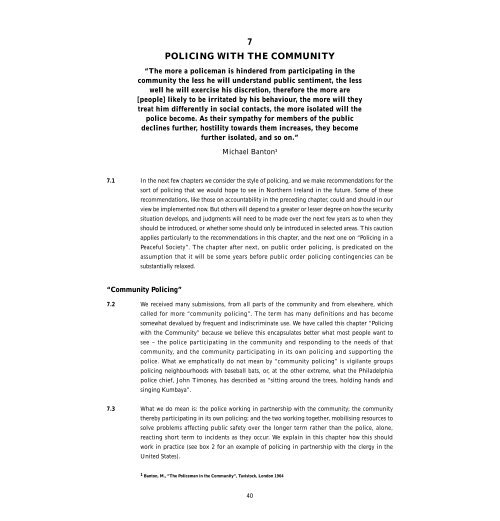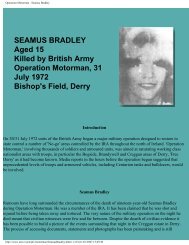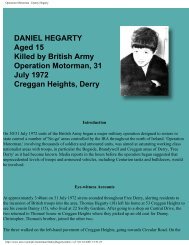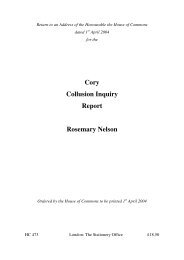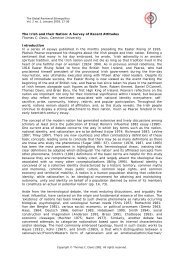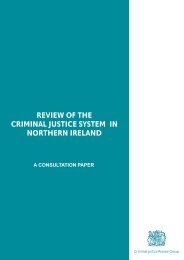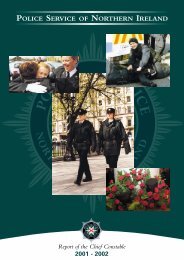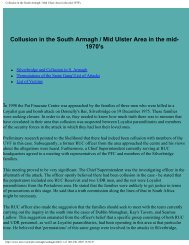7 POLICING WITH THE COMMUNITY - CAIN
7 POLICING WITH THE COMMUNITY - CAIN
7 POLICING WITH THE COMMUNITY - CAIN
Create successful ePaper yourself
Turn your PDF publications into a flip-book with our unique Google optimized e-Paper software.
7<strong>POLICING</strong> <strong>WITH</strong> <strong>THE</strong> <strong>COMMUNITY</strong>“The more a policeman is hindered from participating in thecommunity the less he will understand public sentiment, the lesswell he will exercise his discretion, therefore the more are[people] likely to be irritated by his behaviour, the more will theytreat him differently in social contacts, the more isolated will thepolice become. As their sympathy for members of the publicdeclines further, hostility towards them increases, they becomefurther isolated, and so on.”Michael Banton 17.1 In the next few chapters we consider the style of policing, and we make recommendations for thesort of policing that we would hope to see in Northern Ireland in the future. Some of theserecommendations, like those on accountability in the preceding chapter, could and should in ourview be implemented now. But others will depend to a greater or lesser degree on how the securitysituation develops, and judgments will need to be made over the next few years as to when theyshould be introduced, or whether some should only be introduced in selected areas. This cautionapplies particularly to the recommendations in this chapter, and the next one on “Policing in aPeaceful Society”. The chapter after next, on public order policing, is predicated on theassumption that it will be some years before public order policing contingencies can besubstantially relaxed.“Community Policing”7.2 We received many submissions, from all parts of the community and from elsewhere, whichcalled for more “community policing”. The term has many definitions and has becomesomewhat devalued by frequent and indiscriminate use. We have called this chapter “Policingwith the Community” because we believe this encapsulates better what most people want tosee – the police participating in the community and responding to the needs of thatcommunity, and the community participating in its own policing and supporting thepolice. What we emphatically do not mean by “community policing” is vigilante groupspolicing neighbourhoods with baseball bats, or, at the other extreme, what the Philadelphiapolice chief, John Timoney, has described as “sitting around the trees, holding hands andsinging Kumbaya”.7.3 What we do mean is: the police working in partnership with the community; the communitythereby participating in its own policing; and the two working together, mobilising resources tosolve problems affecting public safety over the longer term rather than the police, alone,reacting short term to incidents as they occur. We explain in this chapter how this shouldwork in practice (see box 2 for an example of policing in partnership with the clergy in theUnited States).1 Banton, M., “The Policeman in the Community”, Tavistock, London 196440
2 – <strong>POLICING</strong> IN PARTNERSHIP: <strong>THE</strong> CLERGYA good example of successful partnership policing is the role of the clergy in some American cities.Santa Ana police, in Southern California, told us they could not have succeeded in reducing crime anddisorder in the most difficult neighbourhoods in their jurisdiction without active engagement by theCatholic Church.In Boston, a group of black ministers have formed a coalition to help bring peace to violentneighbourhoods, with a particular emphasis on youth. The clergy work with gang members, youthsinvolved in drug trafficking, and victims of domestic violence. They offer advice and help overeducation and employment, healthcare and counselling, and over the past few years they havedeveloped with the police a constructive and mutually-reinforcing partnership in place of what wasonce a detached and sometimes hostile relationship. The result is safer neighbourhoods, and moreblack and Latino youth seeking to join the police (see also Chapter 15).Partnership7.4 The arrangements we have proposed in the preceding chapter on accountability providemechanisms whereby the community can express its concerns and priorities to the police and thepolice can explain and report on their conduct and performance. We have also encouraged closecooperation between these accountability mechanisms and other agencies involved in aspects ofcommunity safety. But partnership between the police and the community goes well beyondformal arrangements of this sort, and beyond the less formal Community and Police LiaisonCommittees which may exist at various local levels. Partnership is a matter of policing style, but itis also an attitude of mind, both for police officers and for the public. It is at least as much a matterof philosophy as it is one of method, and it amounts to a profound shift in police thinking andcommunity thinking.7.5 The present policing style of the RUC has been greatly distorted by the security situation, to thefrustration of both police and public. Submissions from many serving and retired officersregretted the difficulty of providing a proper community policing service with the constraintsimposed on them as a result of the threats to their security – fortified police stations, armouredvehicles, firearms, body armour and so on. Many members of the public called for more beatpolicing and for dedicated neighbourhood police officers functioning as part of the community.7.6 We do not believe that the absence of community policing in many parts of Northern Ireland canbe entirely justified as a consequence of the security situation, although we do accept that itexplains a great deal. We have been impressed by the community policing service that some policeofficers have managed to provide, even in difficult areas, in spite of continuing security threats.One example is the Markets area of Belfast (see box 3), where a number of police officers have losttheir lives over the years, most recently Constable Johnston Beacom in 1994, and yet SergeantStevie Jones and his team, patrolling on foot, have managed to build up a community policingpresence which won Sergeant Jones an award as the United Kingdom’s Community Police Officerof the Year in December 1998. We are convinced, from visiting the area ourselves and speaking toresidents, police and community groups, that the success of the community police team there isattributable to their attitude towards the local community, to their patient hard work over a periodof years, and to the response of the community to this style of policing. We believe that a similar41
approach could be successful now in many other parts of Northern Ireland, if the police servicewere determined to pursue it.3 – MARKETS NEIGHBOURHOOD <strong>POLICING</strong> PROJECTEight years ago a team of eight constables and one sergeant was set up in the predominantlynationalist/republican Markets area of Belfast. At that time there was virtually no support for thepolice, and paramilitary organizations conducted their own “patrols” in the area. Over the years theteam built up support within the community and a climate of mutual trust and respect developed. Thepolice now operate effectively, which has brought results in terms of both crime reduction and publicorder policing.The elements of the team’s success are common to successful community policing projects elsewherein the world. They include:• a dedicated policing team for a geographical area, with total responsibility for policing that area• officers with communication, conflict resolution and problem-solving skills who remain with theteam for several years• respect for people of different backgrounds or political convictions• empowerment of the team to determine policing priorities in partnership with the community• foot patrolling as the predominant patrol method• patient and determined development of community activities, including youth schemes andneighbourhood meetings• recognition by senior police managers that the team’s work is important and should not bedisrupted by deployments for duties elsewhere• skilful use of discretion over minor offences, while maintaining a vigorous enforcement regimeagainst more serious offences.7.7 As presently organized the police service is not well geared towards community partnershippolicing, but rather to a more reactive style of policing. This is reflected in the allocation ofresources. For example, at Musgrave Street police station, which is the headquarters of the subdivisionwhich includes the Markets area, of a total complement of 168 officers, only 25 areassigned to community duties while the great majority are assigned to response duties. Theproportions are similar in sub-divisions all over Northern Ireland. Indeed, we learned that atsome sub-divisions, neighbourhood policing teams have recently been reduced rather thanaugmented, in response to pressures on resources. At police headquarters the Community AffairsBranch is an office of eight staff within the department responsible for Operational Support, quiteseparate from the regional, divisional and sub-divisional commands. The term “CommunityAffairs” suggests to us that working with the community is seen as a specialist activity, and the wayin which it is staffed and resourced suggests that it is at the margin of police work – a good thingto do if you can spare the officers and the time to do it, but not the main function of the police.7.8 We believe that neighbourhood policing should be at the core of police work, and that the structureof the police service, the staffing arrangements and the deployment of resources should beorganized accordingly. Box 4 shows how the district police command should be organized in42
support of the neighbourhood police teams; the district headquarters and the specialist units existto support the neighbourhood teams, rather than those teams being a minor unit of the districtcommand. In chapter 12 we show how the entire police organisation should be structured so thatit supports the officer teams working directly with the public. This would radically change theorganization and the way it thinks about itself. It would define the interface between the individualcitizen and the neighbourhood police officer as the prime focus of activity, to which the rest of theorganization becomes a support system. An effective partnership between police and communitymeans a more effective police service and a safer community. A police service that is not engagedwith the community in a continuous way will find it hard to act effectively against crime or disorderin that community, because it will find it hard to know the community and get cooperation from it.4 – ILLUSTRATIVE DISTRICT COMMAND STRUCTURENEIGHBOURHOOD <strong>POLICING</strong> TEAMSEMERGENCYRESPONSETEAMSHELPDESKCRIME& SECURITYTEAMSDRUGSTEAMCASEPREPARATIONCUSTODYCENTREADMINISTRATIVESUPPORTCRIME AND INCIDENTANALYSIS UNITMANAGEMENT TEAMOPERATIONS CRIME PERSONNEL FINANCE AND ADMINISTRATIONACCOPERATIONSDISTRICTCOMMANDERPARTNERSHIPBOARDSmaller District Command Areas have support functions provided by a larger neighbouring area.7.9 We recommend that policing with the community should be the core function of the police serviceand the core function of every police station. This has implications for the structure of the police,for management, for culture and for training, all of which we cover later in this report. Thischapter looks at the components of community policing. Some police officers may expressconcern at such a radical shift in the organization of their resources but the Agreement of 1998,and the levels of resourcing available for policing in Northern Ireland, should together provide aunique opportunity to deliver truly effective locally-based policing in a way that would putNorthern Ireland at the leading edge of such developments in the United Kingdom, Ireland andinternationally. The opportunity needs to be grasped with courage and determination.Dedicated Patrol Teams7.10 Many submissions, from people of all sorts of backgrounds, emphasized the importance of havinglocal police officers who knew the area and were known, by name, to the residents. This is ahallmark of successful neighbourhood policing projects throughout the United Kingdom andoverseas. We recommend that every neighbourhood (or rural area) should have a dedicated policingteam with lead responsibility for policing its area. Each team should be headed by a sergeant, orperhaps in some cases an inspector, as beat manager.43
7.11 We recommend that members of the policing team should serve at least three and preferably five yearsin the same neighbourhood, that they should wear their names clearly displayed on their uniforms,and that their uniforms should also bear the name of the locality for which they are responsible.7.12 Neighbourhood teams will form the core of policing in Northern Ireland and as such shouldconstitute the foundation of police officers’ careers. It is in this environment that officers will learnthe core skills of communication, inter-personal skills, conflict resolution and problem-solving. Werecommend that all probationary police officers undertake the operational phases of theirprobationary training doing team policing in the community.7.13 We further recommend that, where practicable, policing teams should patrol on foot. WilliamBratton, formerly Commissioner of Police in both Boston and New York, has said of patrolling:“Driving around the streets is very different from walking on them. In a patrol car, the only timeyou talk to people is after a crime has occurred. You’re not a fixture in people’s lives. You’re anauthority, not a friend; an occasional presence, not a personality. You become them not us” 2 . TheAmerican academic, George Kelling, calls it “stranger policing”. Clearly it is not practicable forteams covering relatively large patrols in rural areas to do so on foot, but we would hope that theytoo could cover part of their beat on foot, or on bicycles, rather than using cars alone.7.14 We recommend that neighbourhood policing teams be empowered to determine their own localpriorities and set their own objectives, within the overall Annual Policing Plan and in consultationwith community representatives. The beat manager and his/her team should organize their owncommunity liaison mechanisms and, in partnership with schools, clubs, businesses and so on, theyshould decide on such matters as how to programme their patrols – whether, for example, to havea police presence outside schools when the children leave for home, or in dark car parks at theend of office hours. We believe that decisions taken in this way are much more likely to beresponsive to local community needs than directions from senior ranks far removed from theneighbourhood. As the Police Federation said in their submission to us, “accountability to thecommunity must start at the lowest possible level, ie. at the point of delivery of service to theindividual members of the public”.Problem-solving7.15 An integral element of successful community policing is problem-solving. The point here is thatmuch traditional policing has been reactive – responding to specific incidents as they arise. In aproblem-solving approach, such as the SARA (Scan-Analyse-Respond-Assess) method developed bythe US academic Herman Goldstein with the Thames Valley Police, police first scan data on policingproblems to identify patterns, then analyse those patterns to determine causes, then take action,where appropriate with other agencies, to respond to those causes and finally conduct an assessmentof whether they have been successful. The objective of problem-solving policing is to solve problemspermanently and not just provide a quick fix which will simply be followed by further calls about thesame problem. To work such an approach effectively requires the police service as a whole to workin support of neighbourhood policing teams. The police must map problems as they occur, by typeof problem, location, time of day, identity of complainants and identity/description of perpetrators.The Audit Commission observed in 1996 that few United Kingdom police services yet did this, andthat North America was more advanced in these techniques 3 .2 Bratton, W., “Turnaround”, Random House, New York 19983 “Tackling Patrol Effectively”. Audit Commission, November 199644
7.16 We recommend that the Northern Ireland police should, both at a service-wide level and at patrolteam level, conduct crime pattern and complaint pattern analysis to provide an information-led,problem-solving approach to policing. This will have implications for information technology,which we address in a later chapter. We further recommend that all police officers be instructed inproblem-solving techniques and encouraged to address the causes of problems as well as theconsequences (the priority being to train beat managers and their teams); and that they be regularlyappraised as to their performance in doing so.7.17 Problem-solving is not something that the police can do alone. Community partnerships andliaison are essential. If, for example, it is discovered that a prime cause of the petty crime or antisocialbehaviour afflicting an area is that there are no facilities for young people in that area, thepolice beat manager will have to seek help from community leaders and groups to get the matteraddressed. It may sometimes be necessary for beat managers to attend meetings of the DistrictPolicing Partnership Boards to discuss problems that are not easily resolved at a more local level,particularly if District Council or agency action or funding may be needed. DPPB members andother community leaders will also need to understand the problems confronting the police, andwe recommend that they too should be able to attend police training courses in problem-solvingtechniques.Help desks7.18 Members of the public should know whom to call if they need police assistance. Many people mayprefer to speak to an officer they know rather than a telephone voice they do not recognize or ananswering machine. Beat managers should be encouraged to set up mechanisms whereby they ortheir team members can be contacted by area residents if they are needed. Help desks at policestations may be one way of doing this. Some police officers organize regular “surgeries” in theirpatrol areas. There are various ways of addressing this need, and managers should work out withtheir local community what suits them best. The community in turn needs to have a goodunderstanding of what they can expect from the police, in the context of agreed local priorities.Not all 999 calls, for example, can receive the same immediate response; public and police needto be clear about how such calls should be prioritised.Looking Ahead7.19 Policing with the community is hard work. It requires huge adjustments on the part of the policeservice, as the Royal Canadian Mounted Police (who share the same antecedents as the RUC) havediscovered and are still discovering. It is a very different type of policing from the reactive,security-focussed policing which most police officers in Northern Ireland have been accustomedto over the past decades (although it emphatically does not mean that police no longer need tobe firm on enforcement – they do). It calls for new structures, new management practices and newtraining, all of which we address in later chapters. But if successfully implemented, communitypartnership policing will lead to a police service that is both more widely accepted by thecommunity and more effective in securing the safety of the community. As we said at the start ofthis chapter, this is the way we should like to see policing go forward in Northern Ireland as awhole; but we recognize that the pace of change in some areas will depend on the securitysituation.45


